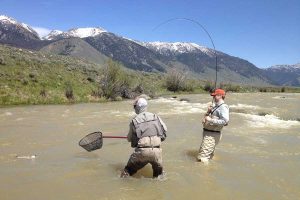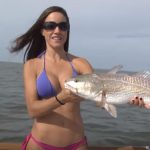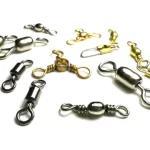Spring runoff can make fishing challenging, but understanding how to read the water during high flows can lead to some of the best fishing opportunities of the season. As snowmelt swells rivers and streams, fish adapt their behavior to changing currents and water clarity. Learning how to identify prime fishing locations and adjust tactics can make all the difference.
1. Understanding How Fish React to Spring Runoff
During spring runoff, rivers experience higher flows, colder water temperatures, and increased turbidity. Fish seek out calmer areas where they can hold without expending too much energy.

Key Fish Behaviors:
- Trout and smallmouth bass move to the edges of currents where the water is slower.
- Predatory fish position themselves behind large rocks or in back eddies to ambush prey.
- Baitfish concentrate in calmer pockets, drawing in bigger fish.
2. Identifying the Best Fishing Spots
Finding the right fishing location during spring runoff requires knowing where fish seek refuge.
Prime Areas to Target:
- Eddies and Backwaters: Fish use these calm pockets to conserve energy while waiting for food to drift by.
- Inside River Bends: Water moves slower along inside bends, making them ideal for fish to hold.
- Behind Large Rocks or Logs: These structures create current breaks where fish can hide.
- Side Channels and Sloughs: These offshoots of the main river offer gentler flows and abundant food sources.
3. Adjusting Your Fishing Approach
Since fish conserve energy in high flows, adjusting tactics is crucial.
Effective Techniques:
- Use Heavier Lures or Flies: Faster currents require weighted baits to stay in the strike zone.
- Target Slow-Moving Water: Focus on areas where fish can hold without fighting strong currents.
- Cast Upstream and Let the Current Carry Your Bait: This presents lures naturally and helps fish locate them in murky water.
- Slow Down Retrieval Speeds: Fish may be less aggressive, so slower presentations increase success.
4. Choosing the Right Gear and Baits
The right tackle setup ensures success when fishing in strong spring currents.
Best Gear Choices:
- Heavier Line: Increased water debris can wear down lighter lines.
- Stronger Rods: A medium-heavy or heavy-action rod helps handle strong currents and larger fish.
- Weighted Flies and Lures: Nymphs, streamers, and sinking crankbaits stay in the strike zone longer.
5. Safety Tips for Spring Runoff Fishing
Fast-moving water can be dangerous, so safety should always be a priority.
Safety Precautions:
- Wear a Wading Belt and Life Jacket: Strong currents can be unpredictable.
- Avoid Wading in Deep, Fast Water: Stick to the edges where the flow is manageable.
- Check Water Levels Before Heading Out: Sudden increases in flow can create hazardous conditions.
Fishing during spring runoff presents unique challenges, but with the right approach, it can be one of the most productive times of the year. By understanding fish behavior, targeting key areas, and adjusting tactics, anglers can turn high-water conditions into prime fishing opportunities. Ready to take on spring runoff? Gear up and test these strategies for a successful fishing trip!
Image: montanaangler





